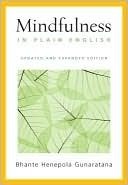More on this book
Community
Kindle Notes & Highlights
Loving friendliness is one of the four sublime states defined by the Buddha, along with compassion, appreciative joy, and equanimity. All four states are interrelated; we cannot develop one without the other. One way to understand them is to think of different stages of parenthood. When a young woman finds out she is going to have a child, she feels a tremendous outpouring of love for the baby she will bear. She will do everything she can to protect the infant growing inside her. She will make every effort to make sure the baby is well and healthy. She is full of loving, hopeful thoughts for
...more
This highlight has been truncated due to consecutive passage length restrictions.
May my mind be filled with the thoughts of loving friendliness, compassion, appreciative joy, and equanimity. May I be generous. May I be gentle. May I be relaxed. May I be happy and peaceful. May I be healthy. May my heart become soft. May my words be pleasing to others. May my actions be kind. May all that I see, hear, smell, taste, touch, and think help me to cultivate loving friendliness, compassion, appreciative joy, and equanimity. May all these experiences help me to cultivate thoughts of generosity and gentleness. May they all help me to relax. May they inspire friendly
...more
The meditation center where I most often teach is in the hills of the West Virginia countryside. When we first opened our center, there was a man down the road who was very unfriendly. I take a long walk every day, and, whenever I saw this man, I would wave to him. He would just frown at me and look away. Even so, I would always wave and think kindly of him, sending him metta. I was not phased by his attitude; I never gave up on him. Whenever I saw him, I waved. After about a year, his behavior changed. He stopped frowning. I felt wonderful. The practice of loving friendliness was beginning to
...more
This highlight has been truncated due to consecutive passage length restrictions.
Let each and every one of us imagine that our minds are free from greed, anger, aversion, jealousy, and fear. Let the thought of loving friendliness embrace us and envelop us. Let every cell, every drop of blood, every atom, every molecule of our entire bodies and minds be charged with the thought of friendliness. Let us relax our bodies. Let us relax our minds. Let our minds and bodies be filled with the thought of loving friendliness. Let the peace and tranquillity of loving friendliness pervade our entire being. May all beings in all directions, all around the universe, have good
...more
May my adversaries be well, happy, and peaceful. May no harm come to them, may no difficulty come to them, may no pain come to them. May they always meet with success.
When we are angry with someone, we often latch on to one particular aspect of that person. Usually it’s only a moment or two, enough for a few harsh words, a certain look, a thoughtless action. In our minds, the rest of that person drops away. All that is left is the part that pushed our buttons. When we do this, we are isolating one miniscule fraction of the whole person as something real and solid. We are not seeing all the factors and forces that shaped that person. We focus on only one aspect of that person — the part that made us angry.
When we are angry with someone, we can ask ourselves, “Am I angry at the hair on that person’s head? Am I angry at his skin? His teeth? His brain? His heart? His sense of humor? His tenderness? His generosity? His smile?” When we take the time to consider all the many elements and processes that make up a person, our anger naturally softens.
But, what if someone hurts you? What if someone insults you? You may want to retaliate — which is a very human response. But, where does that lead? “Hatred is never appeased by more hatred,” it says in the Dhammapada. An angry response only leads to more anger. If you respond to anger with loving friendliness, the other person’s anger will not increase. Slowly it may fade away. “By love alone is anger appeased,” continues the verse in the Dhammapada.
Most of the points given in this book are drawn from the Tipitaka, which is the three-section compendium of the Buddha’s original teachings. The Tipitaka is comprised of the Vinaya, the code of discipline for monks, nuns, and lay people; the Suttas, public discourses attributed to the Buddha; and the Abhidhamma, a set of deep psycho-philosophical teachings.
In the first century C.E., an eminent Buddhist scholar named Upatissa wrote the Vimuttimagga (The Path of Freedom), in which he summarized the Buddha’s teachings on meditation. In the fifth century C.E., another great Buddhist scholar, named Buddhaghosa, covered the same ground in a second scholastic thesis, the Visuddhimagga (The Path of Purification), which remains the standard text on meditation today.


